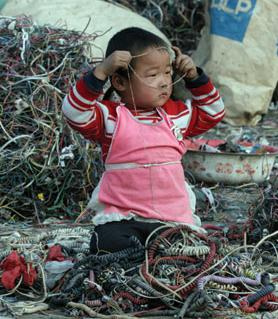
This article part of Right Now’s February Issue, focusing on Technology and Human Rights.
By Erin McGinty.
Have you upgraded your mobile phone lately, or changed over to a new digital television? What did you do with the old handset or TV? You may not have thought about it before, but the way you dispose of your electronic items has consequences for our environment.
What is E-Waste?
Electronic waste, commonly referred to as e-waste, is the largest and fastest growing waste stream in the world. In Australia, e-waste is growing at three times the rate of municipal waste. While the term isn’t difficult to understand, it is important to remember that all components of an appliance, including any attachments that electric currents flow through, are considered e-waste.
Most people aren’t aware that electronic waste, disposed of incorrectly, can severely damage the environment. The Australian Government, and the Australian people, should be concerned about the proper disposal of electronic waste because it affects not only our environment and health, but also the international community.
The toxic chemicals contained in computers, televisions and printer cartridges are dangerous when dumped in landfill. Empty printer inks and toners contain poisonous materials, and computer monitors and old televisions are made up of 20 per cent lead. This toxic material has the potential to seep into groundwater and contaminate the soil, and eventually find its way into our food chain. Health issues that arise from this type of contamination include respiratory problems as well as reproductive, developmental and nervous system problems.
The amount of waste is quite astounding. Up until 2008, 17 million televisions and 37 million computers were sent to landfill in Australia. As a result of the Australian Government’s initiative to switch all Australians over to digital-only television by 10 December 2013, it can only be assumed that more recent figures on the number of televisions sent to landfill have increased.
How has the government addressed the e-waste problem?
While this issue has not been ignored by the Australian Government, it may be that a lack of awareness amongst the general population has made it difficult to effectively implement the legislative changes introduced in 2011 by the Federal Parliament. The Product Stewardship Act provides for shared responsibility between the electronics industry and the government for the reduction of e-waste and an increase in recycling initiatives.
The legislation prompted the establishment of the National Television and Computer Recycling Scheme (NTCRS), which aims to make companies legally responsible for the recycling of electronic items they manufacture or import once those items no longer work. In response to the legislation, TechCollect, a not-for-profit e-waste recycling service, was created with the support of Australian electronic manufacturers and importers. TechCollect provides a free recycling service for households and businesses via a partnership with local councils around Australia.
How does Australia’s e-waste problem affect the international community?

econews.com.au
In September 2011, Dateline broadcast an investigation into the dumping of illegal e-waste in Ghana. The journalist documented hundreds of breaches of the Basel Convention, an international treaty designed to reduce the movements of hazardous waste between countries, particularly the dumping of hazardous waste on less developed countries.
Illegally dumped e-waste contaminates the environment and its effects are worsened when the waste is burnt. The harmful fumes enter the atmosphere affecting neighbouring communities and agricultural land. In Ghana, children and unprotected workers are exposed to these chemicals on a daily basis while searching through piles of dumped televisions and computers for metals that can be sold.
Unfortunately, Australian companies have been implicated in this practice of illegal dumping. By labelling the shipment as ‘second-hand goods’ companies have sent e-waste to less developed countries in order to avoid the costs of disposing of the items correctly. As consumers of electrical goods it is important for us to be mindful of the methods we choose to dispose of such items when they are no longer useable.
Personally, what can you do?
According to Clean Up Australia, the best way to combat increases in e-waste is to reuse or recycle your electronic items. Before disposing of your mobile, TV or computer, check to see if your local schools or charities would like to take them; alternatively, Google owns companies that refurbish electrical equipment.
If you can’t sell, gift or donate your electronic goods, make sure you recycle the items properly. Drop Zone by DHL, an international logistics company, offers a free recycling service for households and small businesses, and, as already mentioned, TechCollect also provide a free recycling service with drop off sites in councils around Australia. Taking responsibility for the proper disposal of e-waste will benefit not only our environment, but will help prevent developing nations from bearing the burden of illegal dumping.
Erin McGinty is a final year Juris Doctor student at the University of Sydney. She has a background in research, with a particular interest in Arabic and Islamic studies and international human rights.

